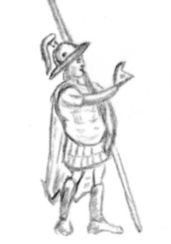- Menander II
-
Menander II Indo-Greek king
Rev: Winged figure bearing wreath and palm, probably Nike. The Kharoshthi legend reads MAHARAJASA DHARMIKASA MENADRASA (Menander, King of the Dharma).
Coin of Menander II.
Obv: Menander wearing a diadem. Greek legend: ΒΑΣΙΛΕΩΣ ΔΙΚΑΙΟΥ ΜΕΝΑΝΔΡΟΥ (King Menander the Just).Reign 90–85 BCE  Coin of Menander II (Indian standard).
Coin of Menander II (Indian standard).
Obv: Warrior standing, armed with spear and sword. Forming a benediction with the right hand, similar to Buddhist vitarka mudra. Greek legend: ΒΑΣΙΛΕΩΣ ΔΙΚΑΙΟΥ ΜΕΝΑΝΔΡΟΥ (King Menander the Just).
Rev: Buddhist lion. Kharoshti legend reads MAHARAJASA DHARMIKASA MENADRASA (Menander, King of the Dharma). Indo-Greek officer (on a coin of Menander II), circa 90 BCE. He is equipped with a cuirass, lamellar armour for the thighs, and leg protections (cnemids).[1]
Indo-Greek officer (on a coin of Menander II), circa 90 BCE. He is equipped with a cuirass, lamellar armour for the thighs, and leg protections (cnemids).[1]
Menander II "The Just" was an Indo-Greek King who ruled in the areas of Arachosia and Gandhara in the north of modern Pakistan.
Contents
Time of reign
Bopearachchi has suggested that Menander II reigned circa 90–85 BCE, whereas R. C. Senior has suggested circa 65 BCE. In that case, Menander II ruled remaining Indo-Greek territories in Gandhara after the invasion of Maues.
Relations to other kings
Menander II Dikaios may have belonged to the dynasty of Menander I Soter, the greatest of the Indo-Greek kings. It was long believed that there was only one king named Menander (see discussion under Menander I) as their portraits were rather similar and Menander II seems to have been a devout Buddhist, just as Menander I was, according to the ancient Buddhist scripture the Milindapanha.
On the other hand, the name Menander could well have been popular in the Indo-Greek kingdom, and the coins of Menander II are not very like those of Menander I nor of those other kings (such as Strato I) who are believed to have belonged to his dynasty. R. C. Senior links Menander II with the Indo-Greek king Amyntas, with whom he shares several monograms and also facial features such as a pointed nose and receding chin. He also suggests a close relation to the semi-Scythian king Artemidorus, son of Maues, since their coins use similar types and are often found together.
There is a small possibility that Menander II, rather than Menander I, is actually the Buddhist Greek king referred to in the Milinda Panha. This point is unsolved however, since Greek sources (Plutarch (Praec. reip. ger. 28, 6)) relate that the great conqueror Menander I is the one who received the honour of burial in what could be interpreted as Buddhist stupas.
More likely, Menander I may indeed have first supported Buddhism, like the other Indo-Greek kings, and was probably the main protagonist of the Milindapanha, on account of his described fame, whereas Menander II, a minor king, may have wholeheartedly embraced Buddhism, as exemplified by his coins.
Coins of Menander II
The coins of Menander II bear the mention "Menander the Just", and "King of the Dharma" in Kharoshti, suggesting that he adopted the Buddhist faith. Menander II struck only Indian silver. These depict the king in diadem or helmet of the type of Menander I, with a number of reverses: a king on horseback, Nike and a sitting Zeus of the type of Antialkidas and Amyntas, but with an added eight-spoked Buddhist wheel.
His bronzes feature Athena standing, with spear and palm-branch, shield at her feet, making a benediction gesture with the right hand, similar to the Buddhist vitarka mudra. Other varieties feature a king performing the same gesture.
On the reverse is a lion, symbol of Buddhism, as also seen on the pillars of the Mauryan King Ashoka. In general, the coins of Menander II are quite few, which tends to indicate a rather small rule.
A contemporary king to represent the Buddhist lion on his coins is the Indo-Scythian king Maues, around 85 BCE.
Preceded by:
PeukolaosIndo-Greek Ruler
(Arachosia, Gandhara)
(90–85 BCE)Succeeded by:
ArchebiosINDO-GREEK KINGS AND THEIR TERRITORIES
Based on Bopearachchi (1991)Territories/
DatesPAROPAMISADE ARACHOSIA GANDHARA WESTERN PUNJAB EASTERN PUNJAB 200-190 BCE Demetrius I 
190-180 BCE Agathocles 
Pantaleon 
185-170 BCE Antimachus I 
180-160 BCE Apollodotus I 
175-170 BCE Demetrius II 
160-155 BCE Antimachus II 
170-145 BCE Eucratides 
155-130 BCE Menander I 
130-120 BCE Zoilos I 
Agathokleia 
120-110 BCE Lysias 
Strato I 
110-100 BCE Antialcidas Heliokles II 
100 BCE Polyxenios 
Demetrius III 
100-95 BCE Philoxenus 
95-90 BCE Diomedes 
Amyntas 
Epander 
90 BCE Theophilos 
Peukolaos 
Thraso 90-85 BCE Nicias 
Menander II 
Artemidoros 
90-70 BCE Hermaeus 
Archebios 
Yuezhi tribes Maues (Indo-Scythian) 75-70 BCE Telephos 
Apollodotus II 
65-55 BCE Hippostratos 
Dionysios 
55-35 BCE Azes I (Indo-Scythian) Zoilos II 55-35 BCE Apollophanes 
25 BCE- 10 CE Strato II & III 
Rajuvula (Indo-Scythian) External links
References
- ^ Photographic reference on a coin of Menander II, circa 90 BCE: Image:MenanderIIQ.jpg
- "The Shape of Ancient Thought. Comparative studies in Greek and Indian Philosophies" by Thomas McEvilley (Allworth Press and the School of Visual Arts, 2002) ISBN 1-58115-203-5
- "Buddhism in Central Asia" by B.N. Puri (Motilal Banarsidass Pub, January 1, 2000) ISBN 81-208-0372-8
- "The Greeks in Bactria and India", W.W. Tarn, Cambridge University Press.
Categories:- Indo-Greek kings
- 1st-century BC Asian rulers
Wikimedia Foundation. 2010.

